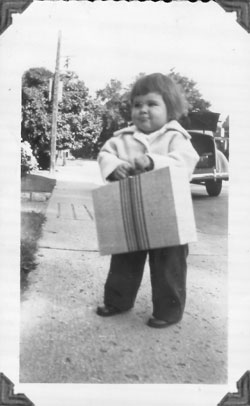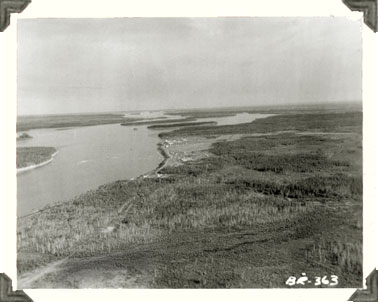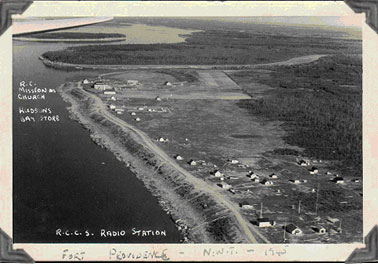Page 1: Fort Providence, NWT
Introduction
Living in the North in the late nineteen-forties and early fifties
was a fascinating experience - one that I have always greatly valued
and never regretted, although at times it was neither easy nor pleasant.
For my husband, Dick Watts, and me the original lure of the North
was a financial one. An extra $100 a month in isolation pay would
make a substantial contribution towards the future purchase of a house
of our own. We decided to make the plunge and asked HQ in Ottawa for
a transfer. During the required interview with a psychologist, Dick
was somewhat surprised when asked if he and his wife liked to play
games. What sort of games was not specified, but the question made
for some interesting speculation for us!
Getting There
I am writing this in the year 2002; it is now fifty-four
years since that day in the summer of 1948 when I went to the airline
office in the Chateau Laurier Hotel in Ottawa to book a flight to
Fort Providence. It was somewhat surprising when the young woman behind
the desk told me that the airline didn't fly there. However, after
I pointed out the settlement's location on the map behind her, she
revised her first response. I was able to book two seats - for my
baby daughter Gillian and myself - for the flight north.
Perhaps it is no wonder that Fort Providence's existence
did not immediately spring to the airline clerk's mind. It is a very
tiny settlement indeed. A close look at the map will locate it in
the Northwest Territories, on the north bank of the Mackenzie River,
almost at the beginning of that river's long journey from Great Slave
Lake to the distant Arctic Ocean.

Jill and her travelling case of toys
Our journey took place in mid-September 1948, Dick
having already arrived at Fort Providence at the beginning of the
month. The first stage, in a Trans-Canada Airlines Dakota, took us
to Edmonton, where in those days the Macdonald Hotel was the tallest
building in town. Little Jill, fifteen months old, was full of energy
during the long flight. Her small attaché case of toys was
not absorbing enough to keep her occupied for the entire trip. I was
very grateful when the kind man next to me, obviously a father himself,
offered to hold her for a while. During the flight he pointed out
to me how the colour of the soil changed to a darker hue when we flew
over Manitoba; I remember being much impressed with this phenomenon.
After deplaning at Edmonton we arrived at last at
the Macdonald Hotel, exhausted after the long flight. It was a something
of a shock when the receptionist, refusing to believe that I had made
a reservation, stated that the hotel was full. My father-in-law, an
old soldier himself, had advised me to get a letter of confirmation
of our reservation - his advice proved to be a very good idea indeed.
On production of this undeniable proof we were finally admitted, and
went to bed in peace and comfort for the night.
Very early next morning, we took a taxi from the
hotel to the Edmonton airport and boarded the Canadian Pacific Airlines
plane, a Dakota DC-3, for the long haul north. After flying 1500 miles
over nothing but an enormous quantity of bush, with an occasional
isolated little settlement in its midst, we finally arrived at the
Fort Providence airstrip. We were now farther away from Ottawa than
Ottawa was from London. As a war bride from England I felt this to
be a most impressive display of the incredible vastness of Canada.

Fort Providence airstrip
Arrival
The only buildings to be seen on the bush-encircled airstrip were
empty H-huts left over from its wartime construction by U.S. troops.
The "boys" at the wireless station had apparently been quite
sure I would be horror-struck at the sheer emptiness of this arrival
spot. Actually, it reminded me of my childhood in the Australian bush,
where my family had lived for two or three years in the twenties,
so its lonely deserted aspect had a rather familiar feeling for me
- I failed to be shocked.
Dick was a very welcome sight. He had driven in the
station truck the three miles from the settlement, and was waiting
to meet us at the airstrip. The truck, a half-ton Dodge "Beep,"
was one of only two motor vehicles in the tiny settlement; the other
belonged to the Hudson's Bay post. Traffic on the few roads consisted
of pedestrians and sleds pulled by dog teams, so there was not very
much traffic duty for the local RCMP.

Fort Providence (Zhahti Koe: "Mission House")
When Alexander Mackenzie stayed at Fort Providence
in the eighteenth century, some Yellowknifes, a Chipewyan people,
were living there. The present settlement was founded by South Slaveys
of the Dene nation, not long after the Roman Catholic Church established
a mission school there in 1896. The Hudson's Bay Company established
a fur trading post at about the same time. The usual northern joke
about the Hudson's Bay Company's initials standing for "Here
Before Christ" was not very apt here; this time Church arrived
before Commerce! During our time there we noticed that the Natives'
surnames were mostly French and Scottish, which presumably reflected
their families' historic connections to the fur traders, voyageurs,
and missionaries.
When I arrived in the tiny settlement, Fort Providence
lay in a narrow strip along the north bank of the Mackenzie River.
From the airstrip we drove along the main road, which ran through
the bush, parallel to the river, to Fort Providence. First we passed
the RCMP compound on the left, and then, after more bush and two or
three Native cabins, we reached the Signals station compound with
its 96-foot-high radio masts. Beyond this welcome sight were, facing
the river on the right-hand side of the road, more houses, the Hudson's
Bay Company trading post buildings, the Roman Catholic Mission church,
the Mission boarding school, and the Oblate Fathers' buildings. The
road finally ended at the docking area, where the river tugs deposited
the loads from their barges and the occasional small plane landed
on the snye (channel) beyond.
The broad Mackenzie River, along whose northern bank
the settlement lay, was of enormous importance in our lives. Originally
the only means of transportation in that part of the Northwest Territories
- apart from dogsleds - it was the principal route for supplies from
the South. When one looks at an atlas, one instinctively looks up
the page to find north, so one thinks "up north" must be
the logical expression. However, the sight of this impressive mass
of water flowing rapidly downriver to its Arctic Ocean outlet instantly
convinces one that the local usage, "down North," is more
appropriate!
At Fort Providence the river was both pure and fast-running.
It provided us with excellent water for drinking and for washing ourselves,
our clothes, and our homes, as well as for watering our small crops.
Fish from the river fed both people and dogs. In the summer, one could
even swim in its waters whenever - very occasionally - the temperature
reached a respectable level!
The fall freeze-up of the river was complete by the
end of October. In our hamlet, as in many places in Canada, a good
many bets were placed on the date the ice would break up in May. Spring
break-up began somewhat grudgingly at first and then proceeded with
noise and commotion and days of miniature icebergs floating downriver
from Great Slave Lake. Ice was still floating by on my birthday in
early June.
[Next
Page]
Pages: [1] [2]
[3] [4]
[5] [6]
[7] [8]
[9] [10]
[11] [12]
[13] [14]
[15] [16]
Return to top of
page
Return to the Watts
Family page